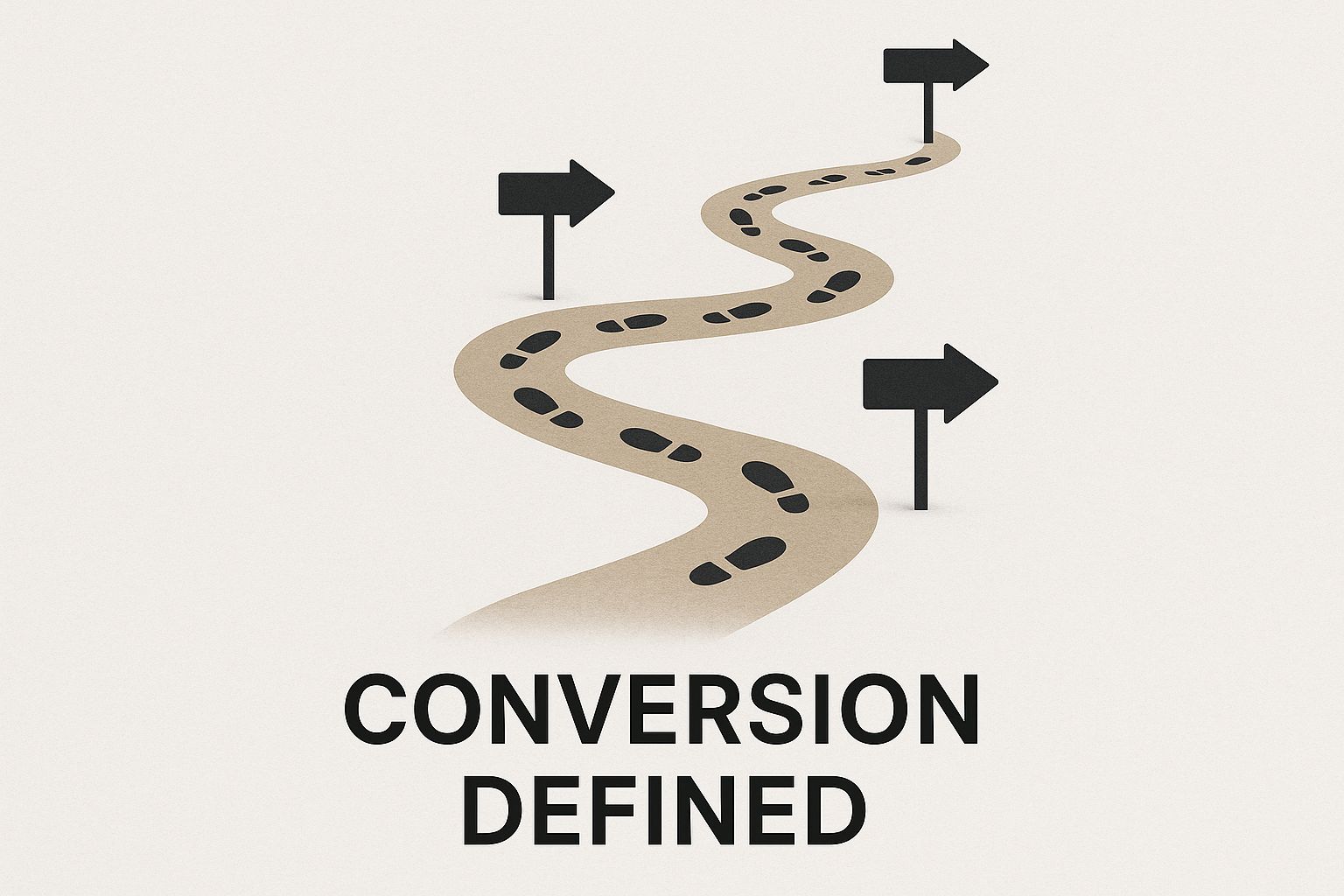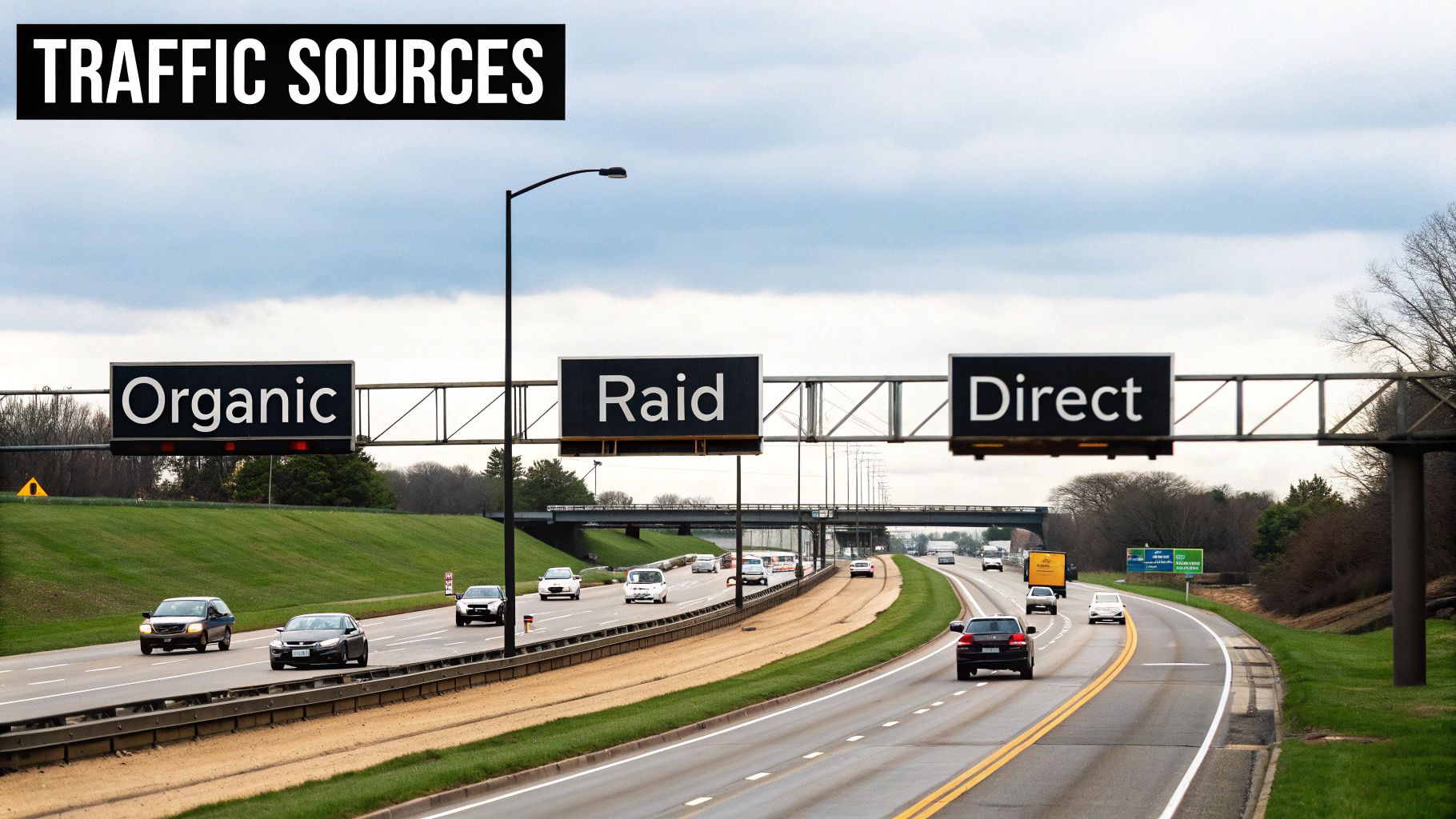In the world of marketing, we talk a lot about conversions. But what does that really mean?
Think of it this way: a conversion is simply the moment a person browsing your website or seeing your ad does exactly what you hoped they would do. It’s that critical point where they stop being a passive observer and take a meaningful step forward.
Defining Your Most Important Marketing Goal
Imagine your entire marketing strategy is a path you've laid out for potential customers. You've placed helpful signs along the way—a catchy social media ad, an insightful blog post, a big, friendly "Sign Up Now" button. A conversion happens when someone follows those signs and reaches one of the destinations you’ve marked on the map.
That destination doesn't always have to be the final sale. While getting someone to click "Buy Now" is often the ultimate goal, many smaller, equally valuable actions build up to it. These are the little nods of agreement, the signals that tell you someone is getting more interested in what you have to offer.
What Counts as a Conversion?
Here's the key: a conversion is whatever you decide it is. Your business goals define the actions that matter most. What's a game-changer for an e-commerce store might be totally different for a software company.
Some classic examples of conversions include:
- Making a purchase: This is the big one for any online store.
- Submitting a form: Think about someone filling out a contact form or requesting a price quote.
- Signing up for a newsletter: A fantastic way to build a direct line of communication with your audience.
- Downloading content: When someone gives you their email in exchange for an ebook or a guide, they've just become a lead. For a deeper dive, our guide explains what are leads in business and why they're so vital.
- Starting a free trial: A crucial first step for any subscription-based service.
This infographic does a great job of showing the conversion journey as a clear, intentional path with specific milestones.

As you can see, a conversion isn't just a random click. It's the successful end of a journey you've carefully designed for your audience. Grasping this idea is the first real step toward building a marketing engine that doesn't just run but actually produces measurable results.
To make these ideas stick, here’s a quick-reference table summarizing the core concepts we've just covered.
Key Conversion Concepts at a Glance
| Concept | Brief Explanation | Example |
|---|---|---|
| Conversion | A specific, desired action taken by a user that aligns with your business goals. | A customer completes a purchase on your website. |
| Goal-Defined | The business's objectives determine what counts as a valuable conversion. | A B2B company might prioritize demo requests. |
| Marketing Path | The journey you create for users, guiding them from initial awareness to a conversion action. | An ad leads to a landing page with a sign-up form. |
| Lead Generation | A type of conversion where a user provides their contact information, becoming a potential customer. | Downloading a whitepaper by entering an email. |
This table helps put the foundational pieces together. Understanding each element is essential before we move on to measuring and improving them.
The Two Core Types of Marketing Conversions

It’s tempting to think all conversions are equal, but they’re not. Think of it like a football game: you have the game-winning touchdown, but you also have all the smaller first downs that got the team down the field. Your marketing works the same way.
To really get a feel for your customer's journey, you need to understand both the major goals and all the little steps that lead up to them. These different actions fall into two buckets: macro conversions and micro conversions.
A macro conversion is the main event. It’s the ultimate action you want someone to take on your site—the championship trophy that directly boosts your bottom line.
A micro conversion, on the other hand, is a smaller step along the way. These are the individual plays that signal a user is engaged and moving in the right direction. Tracking these smaller wins is how you spot what's working and fix what isn't.
Macro Conversions: The Big Wins
Macro conversions are the finish line for your marketing campaigns. These are the make-or-break actions that tell you if your strategy is actually successful because they almost always have a clear dollar value attached. For businesses focused on growth, knowing the right strategies for generating qualified leads is the key to hitting these big conversion goals.
Here are a few classic examples of macro conversions:
- Making a purchase: The bread and butter for any e-commerce store.
- Requesting a quote or demo: A huge goal for B2B and software companies.
- Submitting a lead form: Essential for service businesses from law firms to contractors.
- Starting a paid subscription: The ultimate goal for SaaS platforms or media sites.
When someone completes one of these, they’ve finished the main journey you laid out for them.
Micro Conversions: The Steps That Get You There
While macro conversions grab all the glory, micro conversions are doing the hard work in the background. They give you priceless feedback on your customer’s experience long before they ever get to the checkout page.
Focusing on micro conversions lets you fine-tune every part of the user journey. When you improve these smaller interactions, you pave a much smoother road to your ultimate macro conversion.
So, what do these smaller steps look like?
- Signing up for an email newsletter
- Creating a user account
- Adding an item to a shopping cart
- Downloading a whitepaper or guide
- Watching over 75% of a product video
Each one of these actions is a vote of confidence. They show genuine interest and commitment from a potential customer.
By keeping an eye on both macro and micro conversions, you get the full story of what motivates your audience. This lets you build a smarter marketing strategy that doesn't just push for the final sale but also nurtures every single step it takes to get there.
How to Calculate and Track Conversion Rates
https://www.youtube.com/embed/X1IrczXHbtU
Knowing what a conversion is gets you to the starting line, but that's it. To actually win the race, you have to measure your performance. Without tracking, you’re just throwing money and effort into the void and hoping for the best.
The key metric here is your conversion rate. It’s a straightforward percentage that shows how many people who saw your campaign or visited your site actually did the thing you wanted them to do. Measuring this turns marketing from a guessing game into a science, showing you exactly what’s working and what’s falling flat.
The Basic Conversion Rate Formula
Calculating your conversion rate is surprisingly simple. You don't need a math degree or fancy software to figure out the basics. The formula itself is easy to remember and applies to just about any marketing channel you can think of.
Conversion Rate = (Total Number of Conversions / Total Number of Visitors) x 100
Let's make that real. Say your landing page got 1,000 visitors last month, and 50 of those visitors signed up for your newsletter (that's the conversion). The math would look like this: (50 / 1,000) x 100 = 5%. Just like that, you have a 5% conversion rate—a clear, hard number you can use as a benchmark.
This simple calculation is the first step in a much larger journey. For a complete picture of your performance, you can explore our guide on how to measure marketing effectiveness to dig into more advanced metrics.
Essential Tools for Tracking Conversions
While the formula is simple, trying to manually count every visitor and every conversion is a recipe for a headache. That’s where tracking tools come in. They do the heavy lifting for you by automating data collection and giving you accurate insights into how people behave.
Here are the workhorses most marketers rely on:
- Google Analytics 4 (GA4): This is the gold standard for website analytics. You can set up "Events" in GA4 to automatically track almost any conversion you can imagine, from someone filling out a form to watching a video.
- Ad Platform Pixels: Services like Meta Ads and Google Ads provide a small snippet of code—a tracking pixel—to place on your site. This pixel watches what users do after clicking your ad, which is absolutely vital for figuring out your return on ad spend.
- Customer Relationship Management (CRM) Software: A good CRM, like HubSpot or Salesforce, tracks the entire customer journey. It connects the dots between a marketing campaign and a final sale, showing you which efforts bring in the best, most valuable customers.
Once you have a clear picture of your current conversion rates, the real work begins: making them better. Learning to implement effective conversion rate optimization best practices can turn good results into great ones. These tools provide the raw data you need to make smart decisions and turn your marketing into a reliable engine for growth.
Benchmarking Your Success Against Industry Standards
So, you’ve done the math and calculated your conversion rate. Now for the big question: Is it any good?
A 5% conversion rate could be a massive win for one business but a serious red flag for another. The honest answer is that a "good" conversion rate is completely relative. Context is everything.
Comparing your performance without knowing your industry’s average is like comparing a sprinter to a marathon runner. Sure, they’re both athletes, but their measures for success are worlds apart. Things like your product's price, how long it takes to make a sale, and the amount of trust you need to build with a customer all dramatically change what a strong conversion rate looks like.
Why Industry Averages Matter
Getting a handle on the typical marketing conversion rates in your specific field is crucial for setting realistic goals and spotting real opportunities to get better. For instance, the average global e-commerce conversion rate usually sits somewhere between 2% and 4%.
But a company selling gourmet chocolates will likely see much higher rates than one selling expensive, custom furniture. Why? The customer’s journey and decision-making process are completely different. You can find more great insights into how these rates vary at Speed Commerce.
Knowing these benchmarks helps you answer some pretty important questions:
- Are we falling behind our direct competitors?
- Are the marketing goals we’ve set actually achievable for our industry?
- Where should we focus our efforts to get the biggest bang for our buck?
To give you a clearer picture of how much these numbers can vary, let's look at the average conversion rates across different industries and devices.
Average Conversion Rates by Industry and Device
This table offers a snapshot of typical marketing conversion rates, providing a useful baseline for what you might expect in your sector.
| Industry / Device | Average Conversion Rate (%) |
|---|---|
| All Industries (Desktop) | 4.14% |
| All Industries (Mobile) | 1.53% |
| B2B E-commerce | 2.23% |
| B2C E-commerce | 2.86% |
| Fashion & Apparel | 2.50% |
| Financial Services | 5.01% |
| Legal | 7.40% |
| SaaS | 3.00% |
Source: Data compiled from multiple industry reports.
As you can see, a one-size-fits-all approach to conversion goals just doesn't work. Mobile conversion rates are consistently lower than desktop, and a legal firm’s benchmark is miles away from a fashion brand’s.
Don’t just chase a generic number for a "good" conversion rate. The real goal is to consistently outperform your specific industry's benchmark. That's the true measure of effective marketing.
By understanding the field you’re playing on, you can set smarter goals, put your budget where it will do the most good, and build a strategy that drives real, meaningful growth for your business.
How Different Traffic Sources Impact Conversions

It’s tempting to treat every website visitor the same, but the truth is, where they come from tells you a lot about what they’re likely to do next. Someone who finds you by searching a specific problem on Google is in a completely different headspace than someone casually scrolling through social media who stumbles upon your link.
Not all traffic is created equal. Each source brings an audience with its own unique level of intent, and that intent is the single biggest predictor of whether they’ll convert. If you want to build a truly smart marketing strategy, you have to dig into where your visitors are coming from.
The Power of High-Intent Traffic
Some visitors land on your site ready to take action. Others are just kicking the tires. The source of their visit is usually the clearest clue to which camp they fall into.
Direct Traffic: Think about what it means when someone types your URL directly into their browser. They already know who you are. They didn't just find you; they came looking for you. This group almost always has the highest conversion rates because the trust has already been built.
Organic Search Traffic: These folks have a problem and are actively searching for a solution. They might not know your brand yet, but they know what they need. By showing up for the right keywords, you're meeting a qualified visitor at the exact moment of their need, which makes them prime candidates to convert.
Paid Search Traffic: This is a lot like organic search, but you're paying to get in front of people searching for commercial keywords. You're essentially jumping the line to capture users who are often very close to making a purchase decision.
Analyzing Lower-Intent Channels
On the flip side, some channels are more about planting seeds than harvesting crops.
Take social media or a link from another blog, for instance. Visitors from these sources often have lower conversion rates because they're in "discovery mode." They weren't necessarily looking to buy or sign up right now. These channels are absolutely vital for building brand awareness, but their direct impact on conversions isn't always as immediate.
One of the most consistent findings in marketing analytics is that direct traffic outperforms other channels. Why? Because it represents an audience you’ve already won over through other efforts—they’re coming back for a reason.
Recent data backs this up, showing that direct traffic sources convert best with an average rate of 3.3%. Paid search isn't far behind at 3.2%, proving just how powerful it is to capture users with strong buying intent. You can find more insightful conversion stats over on BloggingWizard.com.
Ultimately, knowing what a conversion is in marketing is just the starting point. The real insight comes from understanding who is converting and where they came from. By breaking down your conversion data by traffic source, you can stop guessing and start investing your time and money into the channels that actually deliver results.
Picking the Right Marketing Channel to Drive Action
Knowing who your audience is and where they come from is only half the battle. The other, arguably more important half, is deciding where you're going to meet them. The marketing channels you choose will make or break your ability to drive conversions because different platforms attract people in completely different states of mind.
Think of it this way: your marketing channels are like different types of conversations. A social media post is like shouting in a crowded room—it’s great for getting attention, but it's a terrible place for a nuanced sales pitch. An email, on the other hand, is a direct, personal note sent to someone who actually asked to hear from you. The context is everything.
Align Channels with What Customers Actually Want
The real secret is matching your channel to your customer's intent at that moment. Some platforms are fantastic for grabbing the attention of people who are ready to buy right now. Others are much better at slowly building awareness and trust over time.
Take Search Engine Optimization (SEO), for example. It’s so powerful because it puts you in front of people who are actively looking for solutions. When your website pops up as the top result for the exact problem they're trying to solve, you're meeting a motivated buyer at the perfect time. That direct line to user intent is why SEO consistently drives high-quality, sustainable conversions.
Email marketing plays a different game altogether, one built on permission and trust. An email list isn't just a bunch of random contacts; it's a curated audience of people who have raised their hand and said, "Yes, I want to hear from you."
Because email marketing is a permission-based channel, it often boasts some of the highest conversion rates. You're not interrupting a stranger; you're speaking directly to an interested subscriber, which is a fundamentally stronger position for driving action.
Comparing the Big Digital Channels
Conversion rates can be all over the map, swinging wildly from one channel to the next and even between industries. For instance, SEO generally pulls in a conversion rate between 2.1% and 2.6%. Meanwhile, a well-targeted email campaign can hit closer to 2.8%. And as this digital marketing report shows, some industries like legal services can see conversion rates as high as 12.3% with a focused strategy.
To build a plan that actually works, you have to think about how each channel fits into your overall goals:
- SEO: Your best bet for attracting high-intent organic traffic that converts reliably over the long haul.
- Email Marketing: Perfect for nurturing the leads you already have and encouraging repeat business from an audience that trusts you.
- Social Media: Great for building a community and brand awareness, which indirectly fuels conversions down the line.
- Paid Ads (PPC): The go-to for capturing immediate, high-intent traffic for a specific offer or campaign.
Choosing the right mix means looking at the entire customer journey, not just one piece of it. To see how these channels fit together, check out our guide on how to get customers via a sales funnel.
Got Questions About Marketing Conversions?
As you start wrapping your head around marketing conversions, a few questions always seem to surface. Let's tackle some of the most common ones to clear things up and help you feel more confident.
What’s the Difference Between a Lead and a Conversion?
It’s easy to get these two mixed up, but the distinction is pretty simple. Think of “conversion” as the big umbrella term for any meaningful action you want a visitor to take.
A lead, on the other hand, is a very specific type of conversion. It’s that moment when a potential customer hands over their contact information—by filling out a form, signing up for a newsletter, or downloading a guide. A sale is also a conversion, but it's not a lead.
So, here's the bottom line: all leads are conversions, but not all conversions are leads.
How Long Does It Really Take to Improve Conversion Rates?
Ah, the million-dollar question. The honest answer is: it depends entirely on what you're changing. Some tweaks can deliver results surprisingly fast, while bigger projects are more of a slow burn.
- A simple A/B test on a landing page headline or call-to-action button? You could see a statistically significant winner in just a few weeks, especially if the page gets a lot of traffic.
- Rolling out a major website redesign or a comprehensive SEO strategy? You’ll likely need 3-6 months to see the needle really move as you build momentum and authority.
The real goal isn't just speed; it's about making changes that stick. Quick wins are fantastic for momentum, but they deliver the most value when they're part of a smart, long-term strategy.
Should I Focus on Getting More Traffic or a Higher Conversion Rate?
This is a classic dilemma, but for most businesses, the answer is clear: start by improving your conversion rate first. This whole discipline is called Conversion Rate Optimization (CRO) for a reason.
Think about it this way: pouring more money into ads to get more traffic to a "leaky" website is just throwing good money after bad. By optimizing your site for the visitors you already have, you make every dollar you spend on future traffic work harder for you.
Once your website is tuned up and running like an efficient conversion machine, that's when you hit the accelerator on traffic. It becomes a much more profitable and scalable way to grow.
Ready to turn your blog into a conversion powerhouse? Copy Masters delivers 30 search-optimized articles every month, designed to attract high-intent traffic and turn readers into customers. Start outranking your competitors and driving consistent growth today. Learn more at copymasters.co
- SaaS SEO Consulting for Predictable Growth - October 20, 2025
- What Is SEO Management Your Guide to Real Results - October 19, 2025
- A Guide to Quality Content for SEO That Ranks - October 18, 2025
